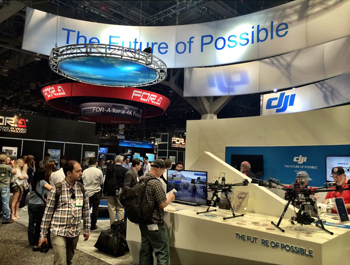FAA Considering Drone Use for Professional Production
A decision from the FAA on the use of drones for production is expected in a few months.
While it continues to reluctantly consider the use of unmanned aerial vehicles (UAVs, also known as "drones") for newsgathering, citing consumer privacy issues, the Federal Aviation Administration is considering allowing production companies to use the POV-style cameras in controlled film and TV production environments.
According to a report in the industry publication Variety, which quoted the agency, a number of video production companies have asked the FAA for an exemption that would allow for the use of UAVs.

At this year's NAB Show in Las Vegas, Drones were a hot item with professional production attendees. "If the exemption requests are granted, there could be tangible economic benefits as the agency begins to address the demand for commercial UAS operations," Variety quoted the FAA. "However, all the associated safety issues must be carefully considered to make sure any hazards are properly mitigated."
The production companies reportedly are asking for exemptions from general flight rules, pilot certificate requirements, manuals, maintenance and equipment mandates, as well as airworthiness certification requirements.
While the controlled environment of a motion picture set to video shoot might appear to be more palatable for the FAA, using drones for newsgathering remains a sticky issue. Earlier this year a photographer for WFSB, the local CBS affiliate in Hartford, Connecticut, was suspended from his job for a week after using his drone to videotape a fatal car accident.
Local police got involved and contacted the station, which in turn suspended Pedro Rivera, who said he was using the drone on his own time. After learning of the incident, the FAA immediately said it would investigate the case. A final report has not been issued. Rivera was reinstated within a week and told not to carry station identification while flying his UAV.
Get the TV Tech Newsletter
The professional video industry's #1 source for news, trends and product and tech information. Sign up below.
As an individual, Rivera is allowed to film accident and crime scenes as long as he does not interfere with the police investigation. The FAA has said that flying a drone for commercial purposes, including journalism, is illegal, although more than a dozen news and media organizations (including the Associated Press, The New York Times Company, and the National Press Photographers Association) as well as the Society of Drone Journalists, have vehemently opposed the FAA's ban, claiming that the agency's restrictions violate First Amendment protections afforded to journalists.
The FAA ban was overturned by a National Transportation Safety Board ruling in March, due in part to its lobbying efforts. The FAA is appealing that ruling.
According to published reports, the news organizations have filed a brief with the NTSB asking that it to confirm the judge's ruling and continue to block similar bans until the FAA makes an exception for the use of small drones.
"This overly broad policy ... has an impermissible chilling effect on the First Amendment newsgathering rights of journalists," the group's brief states. "The federal government, through the FAA and with the NTSB's encouragement, should move forward with the development of polices that protect, rather than hinder, freedom of speech and of the press."
In support of using drones for controlled production environments, Neil Fried, Senior Vice President of government and regulatory affairs for the Motion Picture Association of America (MPAA), told Variety that the use of the unmanned aircraft offers the motion picture and television industry "an innovative and safer option for filming. The new tool for storytellers will allow for creative and exciting aerial shots, the latest in new technologies being used by our industry to further enhance the viewer experience."
The FAA has noted that other industries have also asked for exemptions, including precision agriculture, power line and pipeline inspection, and oil and gas flare stack inspection, according to Variety.
